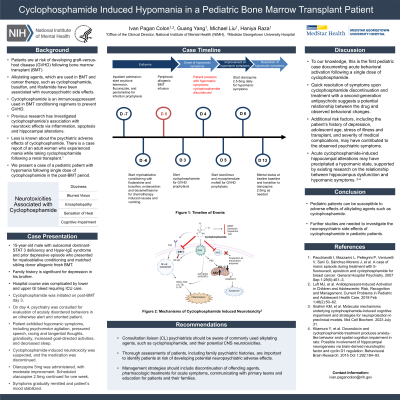Transplant Psychiatry and C-L Subspecialties
(209) Cyclophosphamide Induced Hypomania in Pediatric Bone Marrow Transplant Patient

- IP
Ivan E. Pagan Colon, MD
Consultation-Liaison Fellow
National Institutes of Health / Georgetown School of Medicine
Washington DC, District of Columbia - HR
Haniya Raza, DO, FACLP
Chief, Psychiatry Consultation-Liaison Service
National Institute of Mental Health
Bethesda, Maryland - GY
Guang Yang, PhD
Medical Student
University of Utah
Salt Lake City, Utah 
Michael Liu, B.S.
Research Assistant
National Institute of Mental Health
Rolling Hills Estates, California
Co-Author(s)
Presenting Author(s)
Co-Author(s)
Data on psychiatric side effects of cyclophosphamide are limited to case reports and possible associations in patients concomitantly administered other immunosuppressant medications. Other studies suggest the underlying molecular mechanisms of cyclophosphamide neurotoxicity include oxidative brain damage, neuroinflammation and disruption of neurotransmitter balance (Ibrahim, 2023). Further, animal studies demonstrate cyclophosphamide may acutely impair hippocampal neurogenesis (Kitamura, 2015). One possible hypothesis for our patient is that acute cyclophosphamide-induced hippocampal dysfunction precipitated a hypomanic state. Additional risk augmenting factors should be considered, including prior psychiatric history. The patient had an episode of depression and anxiety two years prior which was treated with psychotherapy with resolve of symptoms within one year. Other factors, including adolescent age and stress of illness and hospitalization should be considered. Due to limited data on the neuropsychiatric side effects of immunosuppressants in pediatric patients, further studies are warranted. 1. Luft MJ, et al. Antidepressant-Induced Activation in Children and Adolescents: Risk, Recognition and Management. Current Problems in Pediatric and Adolescent Health Care. 2018 Feb 1;48(2):50–62.
Background: Cyclophosphamide is an important immunosuppressant used in bone marrow transplant (BMT) conditioning regimens. It has also emerged an effective agent to prevent graft versus host disease (GVHD) both when used alone or with other immunosuppressives. While cyclophosphamide may be uncommonly associated with neurotoxicity, including cognitive impairment and encephalopathy, psychiatric adverse effects are less well characterized. We present a case of hypomania in a 15-year-old male who received cyclophosphamide for GVHD prophylaxis following bone marrow transplant.
Case: DS is a 15-year-old male with autosomal dominant-STAT 3 deficiency and Hyper-IgE syndrome who presented for myeloablative conditioning and matched sibling donor allogeneic fresh BMT. Following transplant, cyclophosphamide was initiated on post-BMT day 3. On day 4, the psychiatry team was consulted for evaluation of disordered behaviors in an otherwise alert and oriented patient. DS was exhibiting hypomanic symptoms, including psychomotor agitation, pressured speech, racing and tangential thoughts, grandiosity, increased goal-directed activities and decreased sleep. Cyclophosphamide-induced neurotoxicity was suspected, and the medication was discontinued on post-BMT day 4. Oral olanzapine 5mg was administered, with moderate improvement. Given persistent hypomanic symptoms, scheduled olanzapine 2.5mg continued for one week then was transitioned to as needed. Symptoms gradually remitted, and DS’s mood stabilized and remained at his baseline throughout the rest of his inpatient stay.
Discussion: Our case presents unusual clinical symptoms emerging acutely following a single dose of cyclophosphamide. Drug-induced behavioral activation in pediatric patients is most commonly associated with antidepressant use and has not been previously linked with cyclophosphamide (Luft, 2018). Our patient had relatively quick resolve of symptoms with cyclophosphamide discontinuation and treatment with second generation antipsychotic.
References:
2.Ibrahim KM, et al. Molecular mechanisms underlying cyclophosphamide-induced cognitive impairment and strategies for neuroprotection in preclinical models. Mol Cell Biochem. 2023 Jul 31.
3. Kitamura Y, et al. Doxorubicin and cyclophosphamide treatment produces anxiety-like behavior and spatial cognition impairment in rats: Possible involvement of hippocampal neurogenesis via brain-derived neurotrophic factor and cyclin D1 regulation. Behavioural Brain Research. 2015 Oct 1;292:184–93.
Presentation Eligibility: Not previously published or presented.
Diversity, Equity, and Inclusion: In this case we present a pediatric case which demonstrating how Consultation-Liaison physicians need to be comfortable working with this population. This case also highlights the importance of liaison work with other specialties such as pediatrics.

